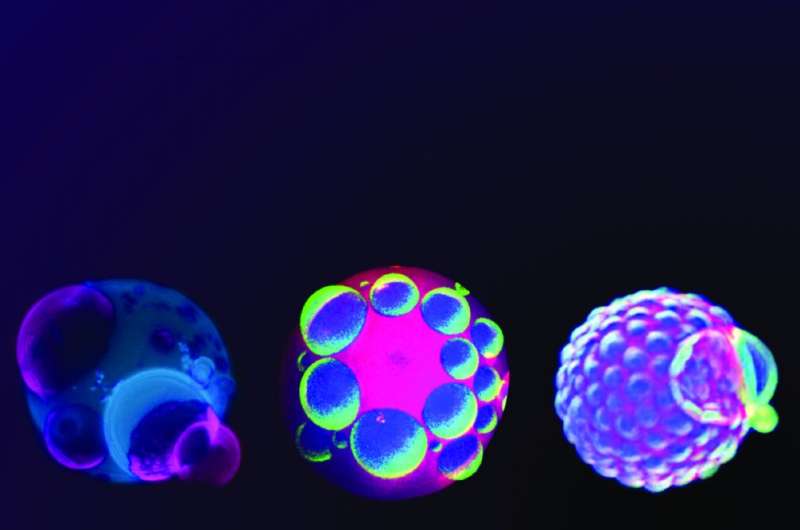‘Lava lamp’ vesicles show how cells could self-organize

The inside of a living cell is crowded with large, complex molecules. New research on how these molecules could spontaneously organize themselves could further our understanding of how cells manage their essential biochemistry in the crowded space. This research may also shed light on how the first living systems appeared and how they evolved their complexities.
Eukaryotic cells contain organized structures, or organelles, bounded by a lipid membrane. An example is the mitochondria, which generate energy in cells. In recent years, scientists have discovered that in addition to these organelles, groups of molecules can spontaneously form into temporary organelle, without a membrane, to carry out some specific function.
“There may be simple physical mechanisms to create specialized ‘designer organelles’ on demand,” said Atul Parikh, professor of biomedical engineering at the University of California, Davis.
Using a simplified model of a cell, Parikh’s laboratory has discovered how mixtures of polymers can parse into phase-separated droplets, like oils in a lava lamp, and that these droplets interact with the cell membrane in unexpected ways, including affecting the exterior structure of the cell. The work is published July 6 in Nature Chemistry.
Wan-Chi Su, a graduate student working with Parikh, created artificial vesicles about the size of a living cell. These are essentially bubbles with a synthetic membrane, containing water with two polymers dissolved in it. Both polymers dissolve in water but repel each other, so if mixed together and left to themselves they would separate into two phases, like an unmixed salad dressing.
Su and Parikh found that when they withdrew water from the vesicles, the polymers would start to form separated droplets, as expected. But instead of progressing to larger and larger droplets, they found that growth was stopped by interactions between the polymer droplets and the inside of the vesicle membrane, creating a mosaic of droplets.
Signaling on outside of cell
These interactions also had an effect on the outside of the vesicle, causing a bubbling or ‘blebbing’ effect. This looks similar to an effect seen in living cells in some circumstances.
“Coupling to the cell boundary prematurely stops phase separation and creates a mosaic of droplets. These 3D droplets inside the vesicle, interestingly, reorganize molecules in the 2D membrane, thus also signaling to the outside of the vesicle,” Parikh said. The researchers are confident that the phenomenon is generally applicable and not specific to this particular combination of molecules.
The work shows how purely physical interactions—how polymers repel or attract each other—can give rise to complex organization in a simplified cell-like system, Parikh said.
“We’re elucidating the physical and chemical principles behind biology,” he said. “It might say something about how life may have come about in the first place.”
Parikh and colleagues plan to expand the work to more complex systems, including living cells.
Additional authors on the paper are Douglas Gettel, UC Davis; James Ho C.S., Nanyang Technological University, Singapore; Andrew Rowland and Christine Keating, The Pennsylvania State University.
More information:
Wan-Chih Su et al, Kinetic control of shape deformations and membrane phase separation inside giant vesicles, Nature Chemistry (2023). DOI: 10.1038/s41557-023-01267-1
Citation:
‘Lava lamp’ vesicles show how cells could self-organize (2023, July 13)
retrieved 13 July 2023
from https://phys.org/news/2023-07-lava-lamp-vesicles-cells-self-organize.html
This document is subject to copyright. Apart from any fair dealing for the purpose of private study or research, no
part may be reproduced without the written permission. The content is provided for information purposes only.
For all the latest Science News Click Here
For the latest news and updates, follow us on Google News.

